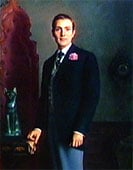Director Albert Lewin and cinematographer Harry Stradling Sr., ASC spearhead classic 1945 screen version of Oscar Wilde's famous tale.

I sent my Soul through the Invisible,
Some letter of that After-life to spell:
And by and by my Soul return'd to me,
And answer'd, "I Myself am Heav'n and Hell."
This verse from The Rubáiyát of Omar Khayyám appears at the beginning and end of a film unlike any other, one in which beauty, wit and horror are intermingled in a unique cautionary tale about the hopeless quest for eternal youth. The Picture of Dorian Gray raised the hackles of critics when MGM released it 53 years ago, but it quickly overcame its initially poor reception to command a devoted following.
The movie, which is as faithful to Irish playwright and poet Oscar Wilde's novel as the strict censorship of the time would permit, begins in 1886 as Sir Basil Hallward paints a portrait of 21-year-old Dorian Gray. The cynical Lord Henry Wotton visits the studio and notes that Dorian's wish — to remain young while the portrait grows old — has been made in the presence of a statue of an ancient Egyptian cat goddess. "It's one of the 73 great gods of Egypt and is quite capable of granting your wish," he says. Dorian replies: "I'd give my soul for that."
Dorian soon falls under the spell of Sir Henry, who believes a man should "give form to every feeling, expression to every thought." The young man subsequently falls in love with an innocent music hall singer, Sibyl Vane, but breaks her heart when he follows Sir Henry's advice to put her purity to the test. When the girl commits suicide, a sneer of cruelty mars the portrait.
Hiding the portrait in his childhood playroom, Dorian determines to spend the rest of his life in the pursuit of pleasure. For 20 years he indulges in every vice imaginable. The portrait changes accordingly, reflecting the bestial soul of the man while Dorian himself continues to appear young. Dorian finally shows the portrait to the horrified artist, Hallward; the painter threatens to tell his niece, Gladys, who is in love with Dorian. Instead, Dorian kills the painter, causing blood to ooze from the right hand in the portrait. A young medical student blackmailed into disposing of the body commits suicide.
When Sybil's seaman brother, who has been searching for her betrayer for 20 years, is accidentally killed at Dorian's country home, Dorian's conscience makes him break with Gladys. The decency of his act alters the painting slightly. Determined to destroy the painting and its temptation, Dorian plunges a knife into its heart, and instantly falls dead. His body becomes the horrible creature of the portrait, while the painting changes back to its original appearance.
Wilde's 1891 novel had been filmed at least seven times before in several countries: Denmark in 1910; America in 1913 and 1915; pre-Revolutionary Russia in 1915; England in 1916; Germany in 1917 and Hungary in 1918. The property came into the hands of writer/director Albert Lewin at MGM in 1943.
Lewin (1894-1968) was 50 at the time, a small, scholarly man who graduated from New York University, earned an MA in English from Harvard, and would have had a PhD from Columbia had he completed his thesis. After seeing the German movie The Cabinet of Dr. Caligari in 1921, he became determined to make movies. Lewin began his climb up the ladder as a reader for Samuel Goldwyn, then graduated to script clerk, film editor, scenarist, associate producer and finally assistant to MGM executive Irving Thalberg. He produced a string of successful pictures, including the mid-1930s blockbusters China Seas, Mutiny on the Bounty and The Good Earth. When Thalberg died in 1937, Lewin went to Paramount as a producer, leaving in 1940 to form an independent company with David L. Loew. In 1943, he returned to MGM as a writer/director. His first project there was Dorian Gray.
Although Lewin had enjoyed a long career in motion pictures, this was only his second directorial effort. The first was Loew-Lewin's The Moon and Sixpence (1942), based on the Somerset Maugham novel. Lewin had written the screenplay and directed because they couldn't afford to hire out the jobs. Some of the ideas Lewin explored in The Moon and Sixpence are developed further in Dorian Gray. One is an unusual narrative technique he devised to capture the style of the book, which is told in the first person by a character who also becomes involved in the action. Lewin had Herbert Marshall tell the story, which the action carried forward, and then pick up the narration at intervals where necessary. The inspiration, Lewin admitted, came from a French film by Sacha Guitry, The Story of a Cheat.
Lewin had also experimented with color inserts in The Moon and Sixpence, which for budgetary reasons had been shot in black-and-white. The picture centers on Strickland (George Sanders), an amoral painter who, like Gauguin, died of leprosy in exile on a tropical island. Lewin commissioned a number of Gauguin-like paintings which were photographed in Technicolor for a sequence in which they are found in a native hut. This effect, another foretaste of Dorian Gray, attracted favorable comment.
Lewin was fascinated by an extraordinary painting at the Art Institute of Chicago, That Which I Should Have Done I Did Not Do, by Ivan Le Lorraine Albright. The large painting depicts in awesome detail a moulding mortuary door with peeling paint, a dead wreath and a fly so realistic that gallery patrons often argued as to whether or not it was real. Lewin wanted this kind of visual decay for Dorian's portrait, and felt that only Albright could capture it.
[ continued on page 2 ]
